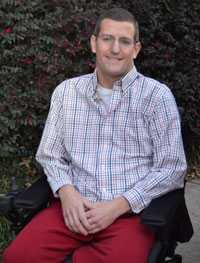Muscular Dystrophy: Kevin’s Story
 Muscular dystrophies are a group of genetic diseases that cause muscle weakness over time. Read about Kevin, a man with muscular dystrophy who doesn’t let the condition define him.
Muscular dystrophies are a group of genetic diseases that cause muscle weakness over time. Read about Kevin, a man with muscular dystrophy who doesn’t let the condition define him.
There are nine major types of muscular dystrophy. These disorders differ in the muscles they affect, the age when signs are first seen, and the genes that cause the disorder.
Kevin’s Story
Kevin was 28 when he was diagnosed with has facioscapulohumeral muscular dystrophy, or FSHD. “I don’t want my identity to be my muscular dystrophy. I don’t want people to think I sit at home and can’t do anything. I don’t ever want to have a day where I don’t have lots to do.”
Leading an active life with muscular dystrophy has its challenges, but Kevin takes them all in stride. There was the frustration this former distance swimmer and three-time Junior Olympian felt when he couldn’t swim 25 yards. And the time he was headed to a black tie dinner only to cancel his plans when he learned that one of the two wheelchair cabs in town was broken. “That was a real ah-ha moment. I don’t want to be in that position again…the position of not being able to do something because of my limited mobility.”
 Kevin was living in Washington, DC when he was diagnosed with FSHD. As the muscle inflammation, wasting, and loss of balance got worse, his doctor suggested he move someplace warmer that had FSHD specialists. Kevin chose Atlanta. “I took a big pay cut. I was looking for a less stressful job with really good insurance. My new company offered long term disability insurance from day one. I was thinking long term without making it sound like I was thinking long term.”
Kevin was living in Washington, DC when he was diagnosed with FSHD. As the muscle inflammation, wasting, and loss of balance got worse, his doctor suggested he move someplace warmer that had FSHD specialists. Kevin chose Atlanta. “I took a big pay cut. I was looking for a less stressful job with really good insurance. My new company offered long term disability insurance from day one. I was thinking long term without making it sound like I was thinking long term.”
“Stairs were tough, but I could do them. Then I decided to use the cane, and then the crutch. I had six trips to the ER during the first two and a half months of the year, all from falls. My doctor said next time it would be a broken hip, and I’d be in the hospital for months. That’s when I got the wheelchair. Now I can do so much more.”
Earlier this year Kevin decided to go on disability. Volunteer work keeps him busy, and his physical and mental health has improved. He works with the Humane Society and helps lead a fundraiser supporting AIDS vaccine development. He’s registering to be a citizen lobbyist during the next Georgia legislative session. Kevin also has an idea to help others with FSHD. “We need something to help people when they’re first diagnosed. New patients ask the same questions. It’s overwhelming to learn you have a disease you can’t even pronounce. Social media is helping connect patients and break down the isolation faced by many with FSHD.”
As Kevin enters his second decade living with muscular dystrophy, he laughs that he turned 40 and got a minivan in the same month. “I don’t think that’s how your midlife crisis is supposed to go.” When asked if he thinks about the next ten years, he says “I can’t go there. I can’t stress about the things I can’t control. Today my life is great.”
CDC would like to thank Kevin for sharing this personal story.
What is muscular dystrophy?
Muscular dystrophies are a group of genetic diseases characterized by progressive weakness and degeneration of the muscles that control movement. Some muscular dystrophies are seen in infancy or childhood, while others may not appear until middle age or later. The disorders differ in the extent of muscle weakness, the rate of progression, and the pattern of inheritance.
Facioscapulohumeral muscular dystrophy is named for the areas in the body that are affected most often: muscles in the face (facio-), around the shoulder blades (scapula-) and in the upper arms (humeral). Weakness in the facial muscles can make it difficult to turn up the corners of the mouth when smiling, drink from a straw, or whistle. Weak shoulder muscles tend to make the shoulder blades “stick out” from the back, and weakness in the shoulders and upper arms can make it difficult to raise the arms overhead. FSHD worsens slowly over decades and can lead to a condition called foot drop which affects walking and increases the risk of falls. Muscle weakness in the hips and pelvis can make it difficult to climb stairs or walk long distances.
There is no specific treatment to prevent or stop muscular dystrophy. Physical and occupational therapy, respiratory therapy, speech therapy, orthopedic appliances, and assistive technology may improve quality of life. Medications can help maintain muscle strength.
More Information
- CDC’s muscular dystrophy website
- MD STARnet
- MDA Muscular Dystrophy Association
- Facioscapulohumeral muscular dystrophy FSH Society
- Myotonic muscular dystrophy Myotonic Dystrophy Foundation
- Congenital muscular dystrophy Cure CMD
- Duchenne muscular dystrophy Parent Project Muscular Dystrophy
- Diagnostic tool for clinicians Child Muscle Weakness
- Page last reviewed: November 16, 2016
- Page last updated: November 16, 2016
- Content source:
- National Center on Birth Defects and Developmental Disabilities, Division of Blood Disorders
- Page maintained by: Office of the Associate Director for Communication, Digital Media Branch, Division of Public Affairs




 ShareCompartir
ShareCompartir